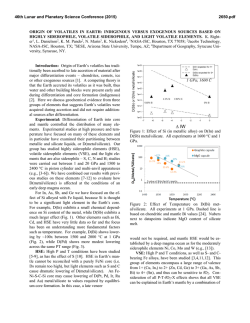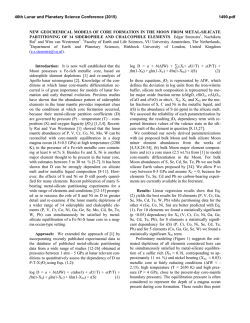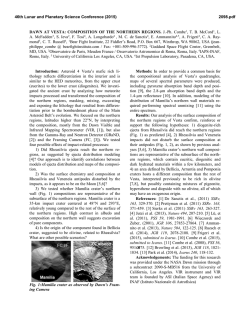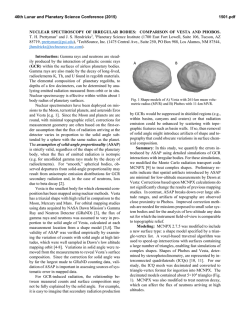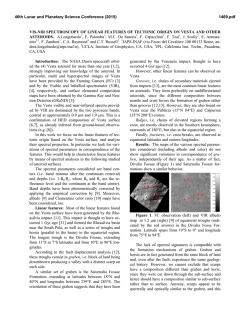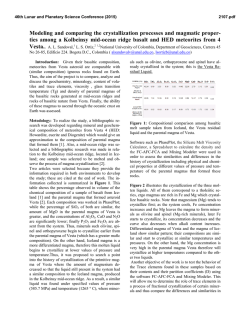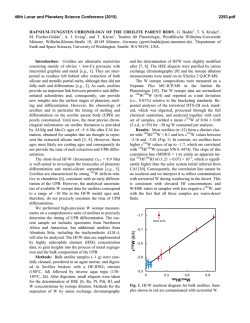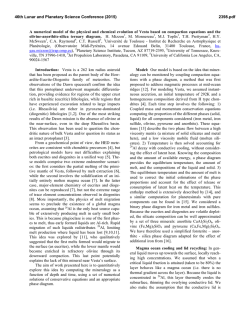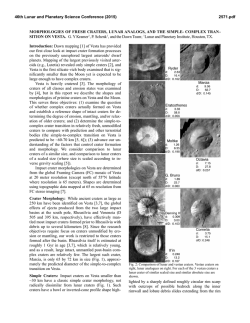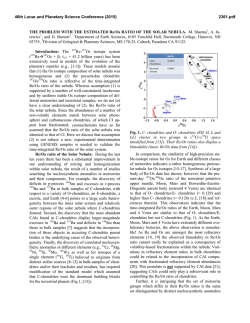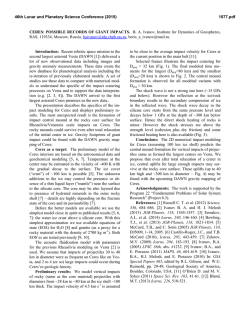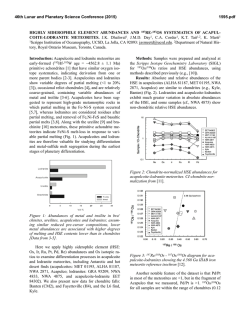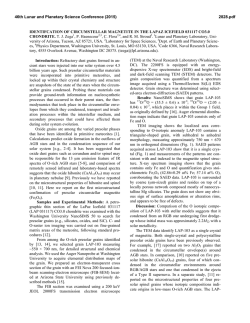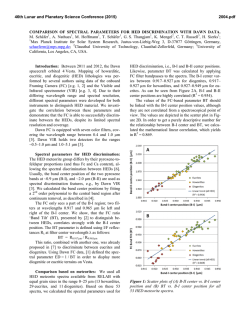
CORE FORMATION IN VESTA: CONSTRAINTS FROM METAL
46th Lunar and Planetary Science Conference (2015) 1421.pdf CORE FORMATION IN VESTA: CONSTRAINTS FROM METAL-SILICATE PARTITIONING OF SIDEROPHILE ELEMENTS Edgar Steenstra1, Nachiketa Rai2 and Wim van Westrenen1. 1Faculty of Earth and Life Sciences, VU University Amsterdam, The Netherlands, 2Department of Earth and Planetary Sciences, Birkbeck University of London, United Kingdom. ([email protected]). Introduction: Studies focused on siderophile element depletions and bulk compositions of the HED meteorite suite [1-9] as well as geophysical observations [10,11] suggest that Vesta has a Fe-rich metallic core. The composition of the core and the prevailing temperature (T) – pressure (P) – redox (fO2) conditions during its formation are poorly constrained. A common approach to constrain conditions of core formation in a planetary body is to link measured mantle depletions of siderophile element to their metal-silicate partition coefficients (D), because D values are governed by PT-X-fO2 conditions. Hence, mantle siderophile element depletion signatures provide important clues to the conditions of core-mantle differentiation [12-14]. From Co, Mo and W abundances in HED meteorites, it was initially inferred that Vesta possessed a core of 40-50 wt.% by mass which segregated from a half-molten silicate mantle [1,2]. Righter and Drake [3] suggested core formation occurred at low-pressure (1 atm), moderate temperature (1873 K) and by liquid-metal liquidsilicate equilibration, resulting in a 10% Vestan core mass. A follow-up study [4] extended their work by considering a wide range of Vestan bulk compositions and found a large range of possible core masses (525%) and S core contents (XS = 0.08-0.22), but a relatively narrow range for T (1780-1803 K) and fO2 (2.6–-1.9 log units below the IW buffer). These models were partly based on D’s obtained at high pressures (up to 20 GPa) not appropriate for the Vestan interior. The study of [14] recently showed the importance of using D’s obtained in the pressure regime of the planetary body in question only, because of changes in pressure dependency of D with pressure [15]. As the maximum pressure in Vesta is < 0.4 GPa [3] parameterizations should be based on D’s obtained at low pressures only. In light of new constraints on Vesta’s geophysical and geochemical properties from DAWN [11], recently proposed new bulk compositions [16-18] and significant expansion of the experimental metal-silicate partitioning database since [4], here we re-examine the conditions at which core-mantle differentiation in Vesta may have occurred. We characterize the dependency of the metal-silicate partition coefficient (D) for Cr, Co, Ni, Cu, Ga, Ge and P on P-T-X-fO2 and assess if there are P-T conditions at which the observed siderophile element depletions are simultaneously satisfied by core-mantle equilibration of a Fe-Ni-S core in a magma ocean-type setting. Approach: We use a wide range of published metal-silicate partitioning data [15,20-31] obtained at pressures <1.5 GPa for Cr, Co, Ni, Cu, Ga, Ge and <3 GPa for P to characterize the dependency of D on P-T-XfO2 using Eqs. (1,2): log D = a + b(∆IW) + c(nbo/t) + d(1/T) + e(P/T) + fln(1-XS) + gln(1-XC) + hln(1-XNi) + i(S) (1) log D = a + b(∆IW) + ∑ciXi+ d(1/T) + e(P/T) + fln(1-XS) + gln(1-XC) + hln(1-XNi) + i(S) (2) In these parameterizations the fO2 term ∆IW represents the deviation in log units from the iron-wüstite buffer, silicate melt composition is represented by molar major oxide fraction terms (cMgO, cSiO2, cAl2O3, cCaO and cFeO) or nbo/t, XS, XC and XNi are the molar values of S, C and Ni in the metallic liquid, and i(S) is the abundance of S (in ppm) in the silicate melt. We assess Eqs. (1,2) for each element and consider the calculated fO2 dependency relative to reported literature data on the silicate melt valence state of the elements involved to assess which equation most realistically represents measured D values [12,32]. In our model we assume Vestan bulk compositions starting from 100% H chondrite [17] and considering a contribution of either a CV (22%) component (suggested from oxygen isotopes [16]) or a CM (25%) component (suggested from assessing a large range of plausible Vestan bulk compositions and comparing them with recent observations from DAWN [17]). We calculate the permissible trace element abundance range in bulk Vesta by attributing the associated abundances of each element in the three chondrite groups reported by [34] relative to their inferred contributions to the bulk Vesta composition. For silicate Vesta trace element abundances, we use the proposed ranges from [4,34-37] based on HED meteorite data. We assume XC = 0, because pressures were too low to allow for significant partitioning of C into the core, supported by the identical C isotope signature of silicate Vesta relative to chondrites [38]. Results: Our regressions show that within this dataset low-valence Co, Ni, Cu, Ge are most realistically predicted with nbo/t (Eq. 1) and higher valence elements P, Ga, Mo, W, and Cr with Eq. (2). With these new parameterizations, we model core formation in Vesta. The calculated metal-silicate D values required to explain the observed siderophile element depletion 46th Lunar and Planetary Science Conference (2015) in the silicate part of Vesta and initital modeling results are shown in Figure 1A. At ∆IW = -2.65, we obtain solutions for all elements, but only at pressures of ≥ 0.1 GPa, XS ≈ 0.16 (corresponding to approximately 10 wt.% S), XNi ≈ 0.15 and T ≈ 1800 K. At conditions more reducing than ∆IW = -2.8, Cr behaves too siderophile. As the Vestan core-mantle boundary is at ≈ 0.1 GPa, this suggests metal-silicate equilibration of a Fe-Ni-S core occurred in a largely molten magmaocean type setting, consistent with [3,4,39,40]. Core cooling in the presence of XS ≈ 0.16 would results in a substantial buoyancy flux which could aid the formation of an ancient core dynamo [41]. High core S also agrees with the high S abundances observed in basaltic eucrites [16,33]. Figure 1 Required log D (dark circles) to satisfy the siderophile element depletions of the Vestan mantle [4,34-37] and modeled log D (open circles) at P = 0.1 GPa, T ≈ 1800 K, XS = 0.16, XNi = 0.15 and i(S) = 1000 ppm at (A) ∆IW = -2.65 and (B) ∆IW = -4.3 1421.pdf Recently, Si stable isotope data on HED meteorites were used to suggest that the core of Vesta formed under highly reducing conditions (∆IW = -4.3 [42]). Figure 1B shows that such a low fO2 is not consistent with the observed siderophile element depletions in Vesta’s mantle. We conclude Vesta did not form under highly reducing conditions, in agreement with results from experimental studies on eucrites [43,44] and the FeO content of bulk silicate Vesta relative to the inferred Fe content of the Vestan core [2]. References: [1] Newsom and Drake (1982) LPSC XIII 592-593. [2] Newsom (1985) JGR 90, C613-617. [3] Righter and Drake (1996) Icarus, 124, 513-529. [4] Righter and Drake (1997) MAPS 32, 929-944. [5] Righter and Drake (1997) LPSC XXVIII, #1350. [6] Kleine et al. (2004) GCA 13, 2935-2946. [7] McSween et al. (2011) SSR 163, 141-174. [8] Zuber et al. (2011) SSR 163, 77-93. [9] Holzheid and Palme (2007) MAPS 42, 1817-1829. [10] Thomas et al. (1997) Icarus 128, 88-94. [11] Russell et al. (2012) Science 336, 684-686. [12] Walter et al. (2000) In Origin of the Earth and Moon, U of A press, Tucson 265-289. [13] Rai and van Westrenen (2013) JGRP 118, 1195-1203. [14] Rai and van Westrenen (2014) EPSL 388, 343-352. [15] Kegler et al. (2008) EPSL 236, 78-95. [16] Lodders et al. (2000) SSR 92, 341-354. [17] Toplis et al. (2013) MAPS 48, 2300-2315. [18] Toplis et al. (2014) Vesta in the Light of Dawn #2033. [19] Consolmagno et al. (2014) AAS-DPS #46. [20] Peach and Mathez (1993) GCA 57, 3013-3021. [21] Gaetani and Grove (1997) GCA 61, 1829-1846. [22] Jaeger and Drake (2000) GCA 64, 3887-3895. [23] Righter and Drake (2000) GCA 64, 3581-3597. [24] Righter et al. (2010) EPSL 291, 1-9 [25] Righter et al. (2011) EPSL 304, 379-388. [26] Siebert et al. (2011) GCA 75, 1451-1489. [27] Wade et al. (2012) GCA 85, 58-74. [28] Kiseeva and Wood (2013) EPSL 383, 68-81. [29] Ballhaus et al. (2013) EPSL 362, 237-245. [30] Mungall and Brenan (2014) GCA 125, 265-289. [31] Wood et al. (2014) GCA 145, 248-267. [32] Corgne et al. (2008) GCA 72, 574-589. [33] Newsom (1995) AGU Ref. Shelf, Washington 159-189. [34] Jones (1984) GCA, 48, 641-648. [35] Dreibus and Wänke (1979) LPSC X 315-317. [36] Dreibus and Wänke (1980) Z. Nat. 35a, 204-216. [37] Righter et al. (2011) EPSL 304, 379-388. [38] Wood et al. (2013) RMG 75, 231-250. [39] Marchi et al. (2014) Vesta in the Light of Dawn #2044. [40] Elkins-Tanton et al. (2014) Vesta in the Light of Dawn #2034. [41] Fu et al. (2012) Science 338, 238-241. [42] Pringle et al. (2013) EPSL 373, 75-82. [43] Stolper (1977) GCA 41, 587-611. [44] Jurewicz et al. (1991) Science 252, 695698. [45] Sarafian et al. (2014) Science 346, 623-626.
© Copyright 2025
